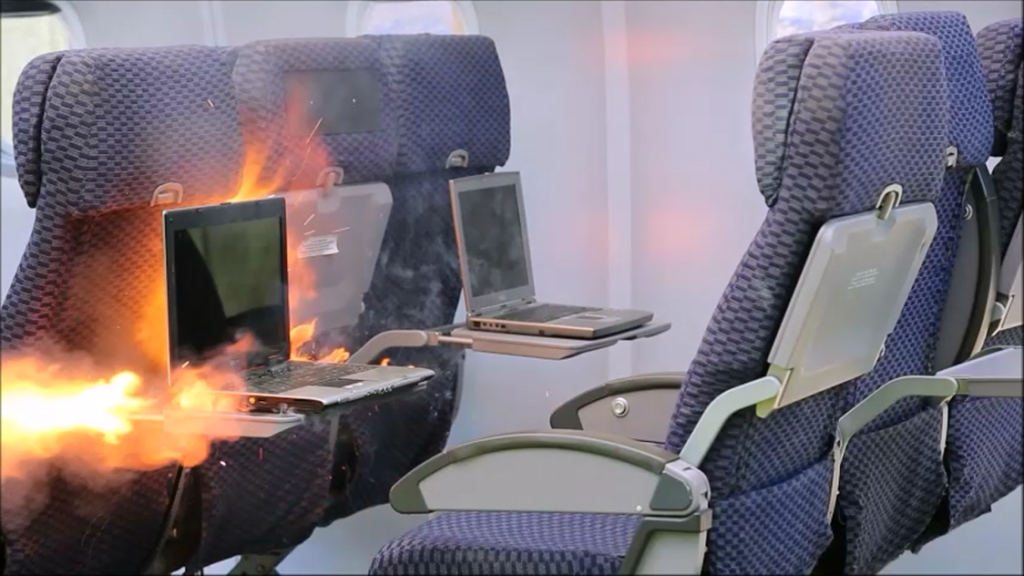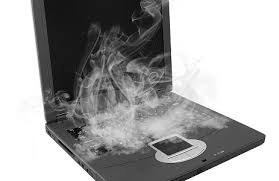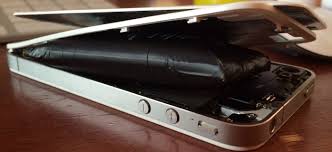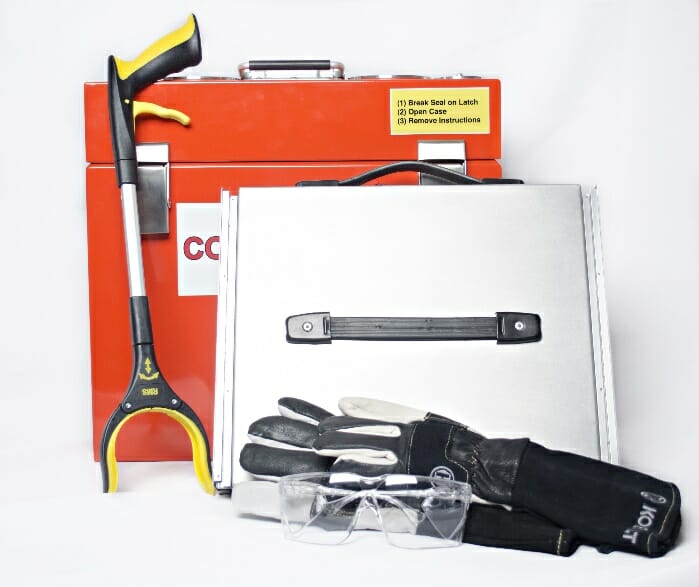You’re flying at 30,000 feet. The person in the seat next to you is watching a video on their laptop computer. You both notice a wisp of smoke coming from beneath the keyboard followed by an acrid odor. Neither of you knows exactly what to do while you watch and listen for another ten minutes. Suddenly, there is a “popping” sound as the laptop computer erupts with a wave of poisonous fumes and noxious smoke. The fumes and smoke quickly begin filling the area around you, and then all the nearby passengers start to panic. Just when you think the situation cannot get any worse, the computer bursts into flames! You are now involved in an on-board Personal Electronic Device (PED) / Lithium-Ion (Li-ion) battery fire and you have nowhere to run or hide!

Sound far fetched? Think again. The Samsung Galaxy Note 7 is just the latest device to be recalled due to an increased battery fire-hazard, but many are not. There have been almost 200 FAA recorded commercial aircraft related PED fire incidents that have occurred over the last ten years, with more than half of these occurring over the last 3 years! (And the FAA admits they do not capture all of the incidents) That’s almost an average of 2 incidents per month. The rate of these incidents is clearly increasing as the number of PED’s (laptop computers, smart phones, Tablet PC’s, e-readers, MP3 players, e-cigarettes, etc.) that are carried on-board by passengers continues to grow.
So what does this all mean and why is this such a problem? First of all, this is not just an aircraft-related issue. PED fires happen every month at home or the road, on the kitchen counter top or in someone’s pocket. Just do a quick internet search of laptop fires, cellphone fires or Li-ion battery fires to see reports of home fires and personal injuries. The more devices you have on board, the greater the probability of an incident.
The Hidden Danger – On an aircraft during such an event, the heat, flames and possible explosion are very bad, but the organic vapors and smoke are much worse! The vapors and smoke will not only restrict your vision and burn your eyes, nose and lungs but these very unique vapors are known to contain neuro-toxins. University studies have found that the vapors contain damaging levels of Hydrofluoric Acid (HF). Per the Hydrofluoric Acid Material Safety Data Sheet (MSDS), the HF vapors may cause irreversible damage to eyes and other mucus membranes. Long term exposure to HF vapors (or higher concentrations) are known to cause rapid respiration, muscular incoordination, fatigue, dizziness, nausea, vomiting, unconsciousness and death (per the MSDS). Other university studies have found (besides HF) trace quantities of diethylflurophosphate. These too are the product of the high temperature reactions of the electrolyte in the Li-ion cells. These compounds, though present in lower concentrations, are also extremely toxic and are key components of nerve agents similar to phosgene (aka “mustard gas”). It is not just “smoke” that you will be breathing!
Thermal Runaway
– The basic phenomena related to Li-ion battery fires is a chemical reaction that is called “thermal runaway” (TR). This condition is not unique to Li-ion batteries (TR also occurs in Ni-Cad batteries) but since Li-ion and Li-ion polymer batteries contain flammable solvents mixed with lithium hexafluorophosphate, the TR problem is greatly exacerbated. If a Li-ion cell becomes overheated for any reason (i.e. 150-200 degrees C), it may set off the TR reaction. Once in TR, the Li-ion cell undergoes a very rapid temperature rise to more than 500 degrees C followed by the venting of flammable vapors, which many times includes flames and an explosion. A single cell in TR is a very exciting event, but a battery with multiple cells in TR is like a runaway freight train. Once the first cell goes into TR, it over-heats adjoining cells, which cascade into TR, rupturing and violently venting the flammable organic electrolyte into the air one by one. To see a laptop battery in complete flaming TR, visit the “How it Works” page at www.PlaneGard.com.
A TR event is a type of battery fire, which is a self-contained chemical reaction. By design, the battery contains a source of oxygen, and therefore a battery fire cannot be extinguished by conventional means such as a fire extinguisher. A fire extinguisher may put out the flames associated with the burning plastic of the PED case, but will not have an effect on the battery fire. Pouring water onto a burning PED may cool the device slightly, but we know that most devices are at least semi-water proof and water has little chance of reaching the battery. And, while you are standing there pouring liter after liter of water, you and your passengers are fully exposed to the toxic vapors, not to mention the flames and flying bits of metal and plastic shrapnel. Be careful! A Li-ion battery in TR must be treated with respect, and therefore, must be quickly captured in a device that is designed to contain all heat, flames, vapors and smoke.
Reasons for Thermal Runaway – There are three basic reasons why a Li-ion battery may go into thermal runaway. In priority order they are: Over-heating, Physical Damage and Manufacturing Defects.
The most insidious reason for Thermal Runaway is related to simply Over-Heating your PED. By the very nature of their computer chips, all PED’s generate heat while operating. If this heat cannot escape, due to a heavy cover or being covered with a blanket or pillow, the battery may become over-heated. Secondly, charging a PED produces heat through various electrical and chemical processes. Therefore charging a cellphone in your briefcase or charging a tablet PC in an airline seat pocket, may cause the device and its battery to over-heat. Too much heat and you may push the battery into thermal runaway.
Also, just leaving your cellphone in the sun or on a hot flight deck, can be very risky. Even if your device is turned off, the sun can produce enough heat to push the battery into TR! It may be tempting, but you are asking for trouble if you place your PED on the glare shield of your airplane! Most of you may know that PED’s have a basic self-protection mechanism that has been cleverly designed to turn themselves off in the event of over-heating. But even when the PED is turn off, the sun can still push the battery into thermal runaway! One final comment about heat and charging. Do not charge your device on a bed or other “soft” surface. Be aware and vigilant. See www.PlaneGard.com for list of PED fire incidents in the air and on the ground.
Physically damaging a Li-ion battery or the PED that contains it, is another issue and has a much higher probability of occurring. For example, dropping or crushing a smartphone or tablet PC can result in an internal battery short circuit, which, in turn generates heat and then pushes the battery into thermal runaway. In fact, recently (Sept 25, 2016), on a Delta flight from Detroit to Amsterdam, a tablet PC was crushed in the electrical mechanism of a First Class airplane cabin seat and set into TR! The plane safely made an emergency landing in Manchester, England but this is the fourth such event to occur in a seat mechanism in the last year! Please be aware that dropping or bending your cellphone or tablet can cause a similar problem.
Though manufacturing defects can lead to a TR event, most manufacturing defects are culled out by the manufacturer before the batteries leave the battery factory. Most battery manufacturers have reliable testing procedures in place, which are designed to catch these defects. It is for this reason that the battery industry reports the probability of TR due to a manufacturing defect to be very low and on the order of 1:10 million. This of course, does not include the recent issue with Samsung Galaxy Note 7, which at this point is believed to be related to a battery manufacturing defect. But generally, manufacturing defects are the least of your worries.
Living on the Edge – Some not so obvious ways of “Living on the Edge” are shown below. These are possible ways to abuse a PED and cause Over-Heating. Please note that over-heating a PED does not always lead to Thermal Runaway, but, as with any low probability event, the more you push it, the higher the probability becomes. (In our lab testing at HighWater Innovations, we can produce a TR event 99% of the time, simply by over-heating the battery pack with a heater cartridge. This is exactly how we produce a TR event for our test videos).
 Identify, Capture & Contain
Identify, Capture & Contain
– This brings us to how best to handle a Thermal Runaway event and eliminate a TR emergency. There are three basic steps to be considered and these are ….. Identify, Capture and Contain.
One of the most important steps in dealing with a PED that may be on the edge of a TR event is to “Identify” the problem early. This is done by learning to how recognize the possible threat, and this comes from awareness and training.
Identify a possible problem: There are four basic signs to look for: Heat, Odor, Smoke and Melting / Bulging. Here’s how they can be identified.
Heat
– Does your PED feel abnormally warm or HOT? This MAY be a sign of a problem but not necessarily. Most devices such as smart phone get warm (and even hot) when mapping or streaming videos. Just be aware. Know your device and what is
not necessarily. Most devices such as smart phone get warm (and even hot) when mapping or streaming videos. Just be aware. Know your device and what is
normal and hat is not. If your device is significantly hotter than normal, you may have id
entified a problem. If you can see any discoloration in the plastic, this can be a sure sign of over-heating and if you are on an airplane, you should play it safe and capture and contain the potential problem.
 Odor – Can you smell burning plastic? Is there an electrical odor? If you can smell an electrical or a chemical odor please be very wary and careful. This is abnormal, so this is the time to act. You have identified a problem, and if you are on an airplane you will wnt to capture and contain quickly.
Odor – Can you smell burning plastic? Is there an electrical odor? If you can smell an electrical or a chemical odor please be very wary and careful. This is abnormal, so this is the time to act. You have identified a problem, and if you are on an airplane you will wnt to capture and contain quickly.
 Smoke – Did you just seek a wisp of smoke? Was it clearly visible? If you saw smoke, you have definitely identified a problem. It is time to act and act quickly. Time to capture and contain before the situation escalates
Smoke – Did you just seek a wisp of smoke? Was it clearly visible? If you saw smoke, you have definitely identified a problem. It is time to act and act quickly. Time to capture and contain before the situation escalates
Bulging or Melting – Does your PED appear thicker  than normal? Is the case melted? Is the back of the PED bulging and separating (see tablet photo at right)? If your device is bulging, this is a sign of an over-heated Li-ion polymer battery and this is a major warning sign. You have definitely identified a dangerous situation. If you are on the airplane it is time to act and capture and contain.
than normal? Is the case melted? Is the back of the PED bulging and separating (see tablet photo at right)? If your device is bulging, this is a sign of an over-heated Li-ion polymer battery and this is a major warning sign. You have definitely identified a dangerous situation. If you are on the airplane it is time to act and capture and contain.
 Capture and Contain the Threat: Once the potential threat has been identified, you must now act to capture and contain the threat quickly and efficiently. This is done with the use of the proper equipment and training. The “proper equipment” is equipment that has specifically been designed and tested for capturing and containing PED fires (not a water bottle and a trash bin!) The proper training is then done using the selected equipment with a well-established and tested procedure. Such a procedure will have well-defined steps, leave little for guess-work and give the crew the tools they require to fly safely.
Capture and Contain the Threat: Once the potential threat has been identified, you must now act to capture and contain the threat quickly and efficiently. This is done with the use of the proper equipment and training. The “proper equipment” is equipment that has specifically been designed and tested for capturing and containing PED fires (not a water bottle and a trash bin!) The proper training is then done using the selected equipment with a well-established and tested procedure. Such a procedure will have well-defined steps, leave little for guess-work and give the crew the tools they require to fly safely.
When selecting the “proper equipment” you must consider the ability of the equipment to fully contain the heat, flames, vapors and smoke. Containing 100% of all four elements of the fire is the key to controlling a TR event in an aircraft. Ignoring just one element of a PED fire can be devastating in the confined space of an airplane. The proper equipment will also allow the flight crew, to capture the threat with minimal chance of personal injury. Having a crew member pick up a smoking PED with their bare hands is not only unsafe but it is extremely dangerous.
 Alternatively, capturing a smoking PED with patented capture and containment technology and well-practiced moves, is the safest way to fight a PED fire. PlaneGard (shown in the photo) has been specifically designed and built to fully address all the elements of a PED fire. The PlaneGard capture device (aka “scoop”) is an effective and safe way to capture a smoking hot PED without actual contact with the burning device. PlaneGard comes complete with everything needed to safely fight a PED fire including: double insulated fire containment case with integral poison gas filters, leather gloves, safety glasses, grabbe
Alternatively, capturing a smoking PED with patented capture and containment technology and well-practiced moves, is the safest way to fight a PED fire. PlaneGard (shown in the photo) has been specifically designed and built to fully address all the elements of a PED fire. The PlaneGard capture device (aka “scoop”) is an effective and safe way to capture a smoking hot PED without actual contact with the burning device. PlaneGard comes complete with everything needed to safely fight a PED fire including: double insulated fire containment case with integral poison gas filters, leather gloves, safety glasses, grabbe r tool (for tight places) and the “scoop”. (see www.PlaneGard.com for operational details). By having PlaneGard on-board, combined with the proper training, the situation described in the first paragraph of this article will be handled quickly and efficiently. PlaneGard will eliminate the panic and the uncertainty caused by an over-heated PED and we at PlaneGard like to say – “Don’t get caught off Gard”!
r tool (for tight places) and the “scoop”. (see www.PlaneGard.com for operational details). By having PlaneGard on-board, combined with the proper training, the situation described in the first paragraph of this article will be handled quickly and efficiently. PlaneGard will eliminate the panic and the uncertainty caused by an over-heated PED and we at PlaneGard like to say – “Don’t get caught off Gard”!



























































































































